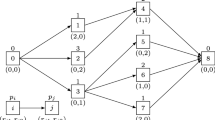Abstract
In the literature, various discrete-time and continuous-time mixed-integer linear programming (MIP) formulations for project scheduling problems have been proposed. The performance of these formulations has been analyzed based on generic test instances. The objective of this study is to analyze the performance of discrete-time and continuous-time MIP formulations for a real-life application of project scheduling in human resource management. We consider the problem of scheduling assessment centers. In an assessment center, candidates for job positions perform different tasks while being observed and evaluated by assessors. Because these assessors are highly qualified and expensive personnel, the duration of the assessment center should be minimized. Complex rules for assigning assessors to candidates distinguish this problem from other scheduling problems discussed in the literature. We develop two discrete-time and three continuous-time MIP formulations, and we present problem-specific lower bounds. In a comparative study, we analyze the performance of the five MIP formulations on four real-life instances and a set of 240 instances derived from real-life data. The results indicate that good or optimal solutions are obtained for all instances within short computational time. In particular, one of the real-life instances is solved to optimality. Surprisingly, the continuous-time formulations outperform the discrete-time formulations in terms of solution quality.









Similar content being viewed by others
References
Alvarez-Valdes R, Tamarit J (1993) The project scheduling polyhedron: dimension, facets and lifting theorems. Eur J Oper Res 67(2):204–220
Ambrosino D, Paolucci M, Sciomachen A (2015) Experimental evaluation of mixed integer programming models for the multi-port master bay plan problem. Flex Serv Manuf J 27(2–3):263–284
Artigues C, Michelon P, Reusser S (2003) Insertion techniques for static and dynamic resource-constrained project scheduling. Eur J Oper Res 149(2):249–267
Artigues C, Koné O, Lopez P, Mongeau M (2015) Mixed-integer linear programming formulations. In: Schwindt C, Zimmermann J (eds) Handbook on project management and scheduling, vol 1. Springer, Cham, pp 17–41
Bianco L, Caramia M (2013) A new formulation for the project scheduling problem under limited resources. Flex Serv Manuf J 25(1–2):6–24
Bixby RE (2012) A brief history of linear and mixed-integer programming computation. Doc Math Extra ISMP:107–121
Chen X, Grossmann I, Zheng L (2012) A comparative study of continuous-time models for scheduling of crude oil operations in inland refineries. Comput Chem Eng 44:141–167
Christofides N, Alvarez-Valdés R, Tamarit JM (1987) Project scheduling with resource constraints: a branch and bound approach. Eur J Oper Res 29(3):262–273
Collins JM, Schmidt FL, Sanchez-Ku M, Thomas L, McDaniel M, Le H (2003) Can basic individual differences shed light on the construct meaning of assessment center evaluations? Int J Sel Assess 11(1):17–29
Grüter J, Trautmann N, Zimmermann A (2014) An MBLP model for scheduling assessment centers. In: Huisman D, Louwerse I, Wagelmans A (eds) Operations research proceedings 2013. Springer, Berlin, pp 161–167
Kaplan L (1988) Resource-constrained project scheduling with preemption of jobs. PhD thesis, University of Michigan
Klein R (2000) Scheduling of resource-constrained projects. Kluwer, Amsterdam
Koch T, Achterberg T, Andersen E, Bastert O, Berthold T, Bixby RE, Danna E, Gamrath G, Gleixner AM, Heinz S et al (2011) MIPLIB 2010. Math Progr Comput 3(2):103–163
Kolisch R, Sprecher A (1997) PSPLIB-a project scheduling problem library: OR software-ORSEP operations research software exchange program. Eur J Oper Res 96(1):205–216
Koné O, Artigues C, Lopez P, Mongeau M (2011) Event-based MILP models for resource-constrained project scheduling problems. Comput Oper Res 38(1):3–13
Koné O, Artigues C, Lopez P, Mongeau M (2013) Comparison of mixed integer linear programming models for the resource-constrained project scheduling problem with consumption and production of resources. Flex Serv Manuf J 25(1–2):25–47
Kopanos GM, Kyriakidis TS, Georgiadis MC (2014) New continuous-time and discrete-time mathematical formulations for resource-constrained project scheduling problems. Comput Chem Eng 68:96–106
Mingozzi A, Maniezzo V, Ricciardelli S, Bianco L (1998) An exact algorithm for the resource-constrained project scheduling problem based on a new mathematical formulation. Manag Sci 44(5):714–729
Naber A, Kolisch R (2014) MIP models for resource-constrained project scheduling with flexible resource profiles. Eur J Oper Res 239(2):335–348
Pritsker AAB, Waiters LJ, Wolfe PM (1969) Multiproject scheduling with limited resources: a zero-one programming approach. Manag Sci 16(1):93–108
Rihm T, Trautmann N (2016) A decomposition approach for an assessment center planning problem. In: Ruiz R, Alvarez-Valdes R (eds) Proceedings of the 15th international conference on project management and scheduling, Valencia, pp 206–209
Stefansson H, Sigmarsdottir S, Jensson P, Shah N (2011) Discrete and continuous time representations and mathematical models for large production scheduling problems: a case study from the pharmaceutical industry. Eur J Oper Res 215(2):383–392
Vanhoucke M, Coelho J, Debels D, Maenhout B, Tavares LV (2008) An evaluation of the adequacy of project network generators with systematically sampled networks. Eur J Oper Res 187(2):511–524
Vielma JP (2015) Mixed integer linear programming formulation techniques. SIAM Rev 57(1):3–57
Zapata JC, Hodge BM, Reklaitis GV (2008) The multimode resource constrained multiproject scheduling problem: alternative formulations. AIChE J 54(8):2101–2119
Zimmermann A, Trautmann N (2014) Scheduling of assessment centers: an application of resource-constrained project scheduling. In: Fliedner T, Kolisch R, Naber A (eds) Proceedings of the 14th international conference on project management and scheduling, Munich, pp 263–266
Zimmermann A, Trautmann N (2015) A list-scheduling approach for the planning of assessment centers. In: Hanzálek Z, Kendall G, McCollum B, Šůcha P (eds) Proceedings of the multidisciplinary international scheduling conference: theory and application, Prague, pp 541–554
Author information
Authors and Affiliations
Corresponding author
Rights and permissions
About this article
Cite this article
Rihm, T., Trautmann, N. & Zimmermann, A. MIP formulations for an application of project scheduling in human resource management. Flex Serv Manuf J 30, 609–639 (2018). https://doi.org/10.1007/s10696-016-9260-8
Published:
Issue Date:
DOI: https://doi.org/10.1007/s10696-016-9260-8




